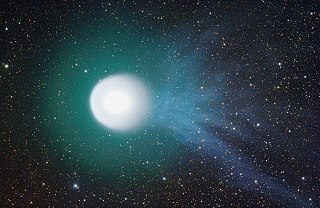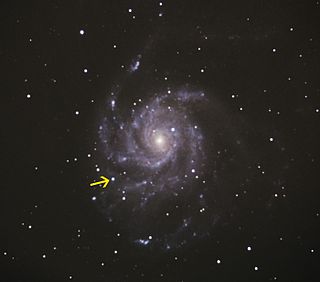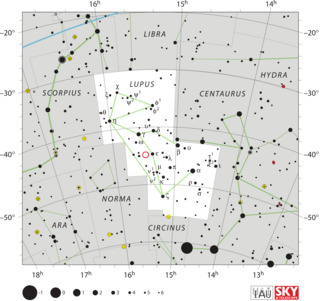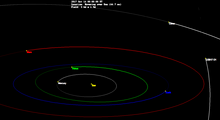Near-Earth Asteroid Tracking (NEAT) was a program run by NASA and the Jet Propulsion Laboratory, surveying the sky for near-Earth objects. NEAT was conducted from December 1995 until April 2007, at GEODSS on Hawaii, as well as at Palomar Observatory in California. With the discovery of more than 40 thousand minor planets, NEAT has been one of the most successful programs in this field, comparable to the Catalina Sky Survey, LONEOS and Mount Lemmon Survey.

Lowell Observatory Near-Earth-Object Search (LONEOS) was a project designed to discover asteroids and comets that orbit near the Earth. The project, funded by NASA, was directed by astronomer Ted Bowell of Lowell Observatory in Flagstaff, Arizona. The LONEOS project began in 1993 and ran until the end of February 2008.
Leuschner Observatory, originally called the Students' Observatory, is an observatory jointly operated by the University of California, Berkeley and San Francisco State University. The observatory was built in 1886 on the Berkeley campus. For many years, it was directed by Armin Otto Leuschner, for whom the observatory was renamed in 1951. In 1965, it was relocated to its present home in Lafayette, California, approximately 10 miles (16 km) east of the Berkeley campus. In 2012, the physics and astronomy department of San Francisco State University became a partner.

The Panoramic Survey Telescope and Rapid Response System located at Haleakala Observatory, Hawaii, US, consists of astronomical cameras, telescopes and a computing facility that is surveying the sky for moving or variable objects on a continual basis, and also producing accurate astrometry and photometry of already-detected objects. In January 2019 the second Pan-STARRS data release was announced. At 1.6 petabytes, it is the largest volume of astronomical data ever released.

The Katzman Automatic Imaging Telescope (KAIT) is an automated telescope used in the search for supernovae.

The All Sky Automated Survey (ASAS) is a Polish project implemented on 7 April 1997 to do photometric monitoring of approximately 20 million stars brighter than 14 magnitude all over the sky. The automatic telescopes discovered two new comets in 2004 and 2006. The ASAS-South, located in Chile and ASAS-North, located in Hawai'i, are managed by Grzegorz Pojmański of the Warsaw University Observatory via the internet.

Comet Pojmański is a non-periodic comet discovered by Grzegorz Pojmański on January 2, 2006 and formally designated C/2006 A1. Pojmański discovered the comet at Warsaw University Astronomic Observatory using the Las Campanas Observatory in Chile as part of the All Sky Automated Survey (ASAS). Kazimieras Cernis at the Institute of Theoretical Physics and Astronomy at Vilnius, Lithuania, located it the same night and before the announcement of Pojmański's discovery, in ultraviolet images taken a few days earlier by the SWAN instrument aboard the SOHO satellite. A pre-discovery picture was later found from December 29, 2005.

Comet Holmes is a periodic comet in the Solar System, discovered by the British amateur astronomer Edwin Holmes on November 6, 1892. Although normally a very faint object, Holmes became notable during its October 2007 return when it temporarily brightened by a factor of a million, in what was the largest known outburst by a comet, and became visible to the naked eye. It also briefly became the largest object in the Solar System, as its coma expanded to a diameter greater than that of the Sun.

Puckett Observatory is a private astronomical observatory located in the state of Georgia. It is owned and operated by Tim Puckett. Its primary observation goals are the study of comets and the discovery of supernovae. To facilitate the latter goal it sponsors the Puckett Observatory World Supernova Search whose astronomers have discovered 369 supernovae.

SN 2011fe, initially designated PTF 11kly, was a Type Ia supernova discovered by the Palomar Transient Factory (PTF) survey on 24 August 2011 during an automated review of images of the Messier 101 from the nights of 22 and 23 August 2011. It was located in Messier 101, the Pinwheel Galaxy, 21 million light years from Earth. It was observed by the PTF survey very near the beginning of its supernova event, when it was approximately 1 million times too dim to be visible to the naked eye. It is the youngest type Ia ever discovered. About 13 September 2011, it reached its maximum brightness of apparent magnitude +9.9 which equals an absolute magnitude of about -19, equal to 2.5 billion Suns. At +10 apparent magnitude around 5 September, SN 2011fe was visible in small telescopes. As of 30 September the supernova was at +11 apparent magnitude in the early evening sky after sunset above the northwest horizon. It had dropped to +13.7 as of 26 November 2011.

C/2012 F6 (Lemmon) is a long-period comet discovered in Leo on 23 March 2012, by A. R. Gibbs using the 1.5-m reflector at the Mt. Lemmon Survey, located at the summit of Mount Lemmon in the Santa Catalina Mountains north of Tucson, Arizona, USA. Initially, the object was considered to be of asteroidal nature before later observations confirmed its cometary appearance. Comet Lemmon has a highly eccentric orbit, bringing it as close to 0.73 AU from the sun at perihelion and as far as 973 AU from the sun at aphelion. This also leads to the comet's long-period nature with an orbital period of approximately 8,000 years based on epoch 2050. The comet last reached perihelion on 24 March 2013.

ASASSN-15lh is an extremely luminous astronomical transient event discovered by the All Sky Automated Survey for SuperNovae (ASAS-SN), with the appearance of a superluminous supernova event. It was first detected on June 14, 2015, located within a faint galaxy in the southern constellation Indus, and was the most luminous supernova-like object ever observed. At its peak, ASASSN-15lh was 570 billion times brighter than the Sun, and 20 times brighter than the combined light emitted by the Milky Way Galaxy. The emitted energy was exceeded by PS1-10adi.
The All Sky Automated Survey for SuperNovae (ASAS-SN) is an automated program to search for new supernovae and other astronomical transients, headed by astronomers from the Ohio State University, including Christopher Kochanek and Krzysztof Stanek. It has 20 robotic telescopes in both the northern and southern hemispheres. It can survey the entire sky approximately once every day.

V407 Lupi, also known as Nova Lupi 2016, was a bright nova in the constellation Lupus discovered by All Sky Automated Survey for SuperNovae (ASAS-SN) on 24.00 September 2016. At the time of its discovery, it had an apparent visual magnitude of 9.1. The ASAS-SN team reported that no object at the nova's location brighter than magnitude 17.5 was seen on images taken four days earlier. Wildly incorrect coordinates were published in the announcement telegram, but corrected in a subsequent telegram. It reached a peak brightness of magnitude 5.6, faintly visible to the naked eye, on 25 September 2016.

V906 Carinae, also known as Nova Carinae 2018, was a nova in the Milky Way galaxy which appeared in the constellation Carina, near the 5th magnitude star HD 92063. It was discovered on images taken on 20.32 March 2018 by the All Sky Automated Survey for SuperNovae (ASAS-SN] telescope at the Cerro Tololo Inter-American Observatory. The ASAS-SN group assigned the name ASASSN-18fv to the object. The discovery image was saturated, allowing researchers to determine only that the object was brighter than apparent magnitude 10. An earlier image obtained by ASAS-SN on 26.32 March 2018 showed the nova was a magnitude ~10.4 object at that time, and the object was not detected on ASAS-SN images taken on 15.34 March 2018 and earlier.

ASASSN-V J213939.3-702817.4 is a star, previously non-variable, found to be associated with an unusual, deep dimming event that was uncovered by the All Sky Automated Survey for SuperNovae (ASAS-SN) project, and first reported on 4 June 2019 in The Astronomer's Telegram.

2019 OK is a near-Earth asteroid noted for its sudden, surprise discovery on the day before its close flyby in 2019. The object's size is estimated at 57 to 130 metres across, the closest asteroid of such size discovered in 2019. It is uncommon for asteroids of this moderately large size to pass within 100,000 km (62,000 mi) of Earth.
ASASSN-19bt was a tidal disruption event (TDE) discovered by the All Sky Automated Survey for SuperNovae (ASAS-SN) project, with early-time, detailed observations by the TESS satellite. It was first detected on January 21, 2019, and reached peak brightness on March 4. The black hole which caused the TDE is in the 16th magnitude galaxy 2MASX J07001137-6602251 in the constellation Volans at a redshift of 0.0262, around 375 million light years away.

C/2021 A1 (Leonard) was a long period comet that was discovered by G. J. Leonard at the Mount Lemmon Observatory on 3 January 2021 when the comet was 5 AU (750 million km) from the Sun. It had a retrograde orbit. The nucleus was about 1 km (0.6 mi) across. It came within 4 million km (2.5 million mi) of Venus, the closest-known cometary approach to Venus.
Tenagra Observatory and Tenagra Observatory II are astronomical observatories in Cottage Grove, Oregon and Arizona. The observatories house heavily automated robotic telescopes.



















